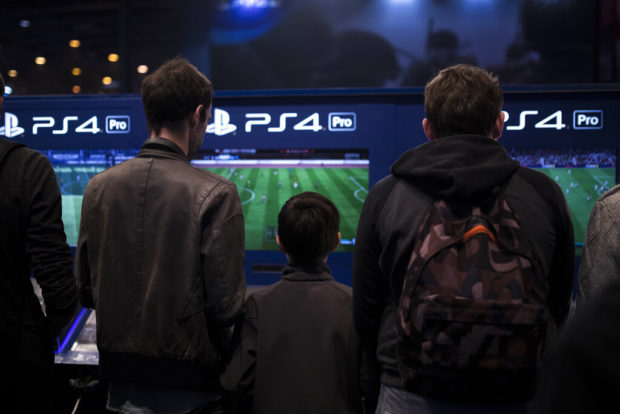
In this Nov. 3, 2017, photo, visitors play FIFA 18 video game on Playstation 4 Pro (PS4) at the Paris Games Week in Paris. Gaming is going green. Companies behind PlayStation, Xbox, Angry Birds, Minecraft, Twitch and other video games and platforms pledged Monday, Sept. 23, 2019, at the U.N. to level up efforts to fight climate change and get their throngs of users involved. (AP Photo/Kamil Zihnioglu)
UNITED NATIONS — Gaming is going green and some of the biggest game companies hope players will, too.
The companies behind PlayStation, Xbox, Angry Birds, Minecraft, Twitch and other video games and platforms pledged on Monday at the United Nations to level up efforts to fight climate change and get their throngs of users involved.
The promises range from planting trees to reducing plastic packaging, from making game devices more energy efficient to incorporating environmental themes into the games themselves.
“I believe games and gamers can be a force for social change and would love to see our global community unite to help our planet survive and thrive,” Sony Interactive Entertainment CEO Jim Ryan said on the sidelines of the UN General Assembly gathering of world leaders.
Ryan said Sony’s plans include outfitting the next-generation PlayStation system with a low-power, suspend-play mode. He said if one million players use it, they could save enough electricity to power 1,000 average US homes.
Playing for the planet
Some games already are set in drowning coastal cities, educate children about wildlife, or otherwise address environmental issues. Former UN Secretary General Ban Ki-moon anointed the Angry Birds character Red as an “honorary ambassador for green” in 2016.
But the idea of gaming green got new visibility with Monday’s commitments from 21 companies, facilitated by the UN Environment Program and showcased against the backdrop of the UN climate summit. With an estimate of more than two billion video game players globally, “this is the most powerful mobilization channel in the world,” David Paul, the Marshall Islands’ environment minister, told the gaming CEOs. His low-lying Pacific island homeland faces an existential threat from rising seas as the planet warms.
The “Playing for the Planet” pledges come from an industry that isn’t always seen as nurturing societal good.
Parents and psychologists have fretted for years about games and other digital diversions sucking young people into staring at screens. The United Nations World Health Organization this year recommended no more than an hour of screen time a day for children under 5, and none at all for those under 1.
Gaming company leaders say that not all screen time is of equal value. They believe their products can engage players on such serious issues as climate change.
“We try to provide entertainment with substance,” Clark Stacey, CEO of WildWorks, said in an interview.
Sustainability messages
Among the initiatives:
WildWorks intends to incorporate new materials about habitat restoration and reforestation into its children’s game Animal Jam, and to plant a tree for every new Animal Jam player.
Microsoft plans to make 825,000 Xbox consoles that are carbon neutral or don’t cause any net increases in heat-trapping carbon dioxide and to promote real-life sustainability activities through its massive-selling game Minecraft.
Angry Birds maker Rovio Entertainment is offsetting carbon emissions generated by players charging electronic devices.
Game streaming giant Twitch, owned by Amazon, intends to spread sustainability messages through its platform.
Google’s upcoming Stadia streaming service is financing research on how people can be inspired to change their behavior through games.
Strange Loop Games already has ecological issues at the heart of its simulation game Eco. Players collaborate to build a civilization and confront its impacts on the environment. If they cut down too many trees, for example, they might kill off a species.
“They’re participatory. They require the player to take action. It’s not just absorbing a message from the outside,” said Erin Hoffman-John, Stadia’s lead designer for research and development.
“For us, it’s less about telling the player about being green or avoiding climate change than letting them have that experience, letting them face that challenge themselves in a world that they care about,” CEO John Krajewski said in an interview. “And then they can bring that to the real world.”